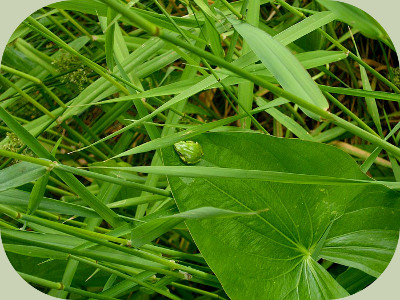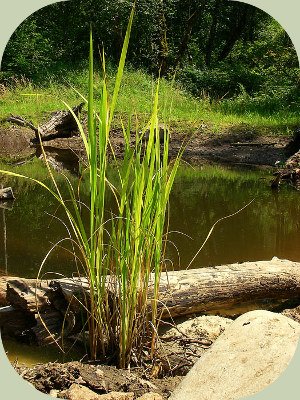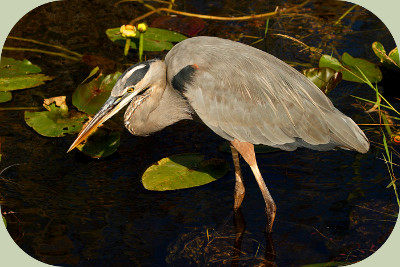Plants for Ponds:
A Permaculture Approach

Knowing key plants for ponds can help you create a new pond or improve an existing one. Permaculture, an ecological approach to sustainable design, provides a framework for choosing beneficial, multifunctional species. Planting species with multiple functions in and around ponds can greatly improve the life and productivity of a pond, benefiting you and many other creatures.
How are Pond Plants Beneficial?
When making considerations for plants for ponds, it helps to understand that different plants provide different functions in a pond. Pond plants can be roughly divided into three main categories: submerged, emergent, and floating. Each group of these plants for ponds provides different general functions within their environment.
Submerged plants are those that are completely underwater and they help add oxygen to the water, provide cover for a variety of small animals from invertebrates to small fish.
Emergent plants are those which are rooted underwater and whose leaves and/or flowers break the surface of the water. This group provides food and cover for small fish, amphibians, birds and even small mammals.
Floating plants are those which float freely on the surface of the water. This group of plants helps provide shade for the pond during warmer times of the year (helping regulate water temperature) and also can provide a source of food for waterfowl and fish species.
Planting species from all three categories helps to create a sustainable pond ecosystem that works together to provide the most benefits for people and wildlife.
Which Plants for Ponds are the Best?
Which pond plants are the best for you and your needs is a very personal matter. Certain species of pond plants do, however, provide more functions and benefits than others. For instance, some plants can provide food, cover, nesting for wildlife as well as useful food and medicine for humans. Multifunctional species are often preferred in a permaculture system. Here are some great species from each of the three categories:
The Best Emergent Plants
- Cattails (Typha sp.) are an excellent choice of plants for ponds, as they provide an incredible range of possible functions and uses including: shelter and nesting sites for small fish/amphibians and birds, they have many edible parts including pollen heads/young shoots and rhizomes, their leaves can be used to make thatching and baskets.
- Tule or Great Bulrush (Scirpus validus) are another great choice as they also share many of the same functions and uses as cattails including: shelter and nesting sites for small fish/amphibians and birds, they have edible seeds/pollen and young shoots, their long and foamy leaves can be used for thatch/mats/baskets/screens.
- Pickerelweed (Pontederia cordata) is a good choice as to provide large, broad leaves to help shade the shallow water, provide cover for amphibians/small fish, and it also has edible seeds and beautiful purple flowers.
- Wapato (Sagittaria sp.) are a wonderful emergent plant that has a long tradition of use by various Native American tribes as food. It has edible tubers, as well as provides cover for amphibians/small fish, and has aesthetically pleasing leaves and white flowers.
- Watercress (Nasturtium officinale) is a member of the mustard family with edible leaves and flowers. It prefers slow moving, shallow, clear waters and can be good habitat for small fish and amphibians. Be careful where you introduce it as it can be fast growing and invasive in some areas.
- Wild Rice (Zizania aquatica) is a perennial grass that grows in shallow waters and produces edible seeds. The vegetative growth provides habitat for amphibians/insects/small fish; while the seeds provide food for birds and people.

The Best Submerged Plants
- Hornwort (Ceratophyllum sp.) is a feathery, floating species that provides excellent cover for baby fish/amphibians and a wide range of small to microscopic invertebrates. Be careful with certain species as they can grow and take over a pond.
- Elodea (Elodea sp.) is a common genus of submerged plants that is also an excellent home and nursery for many small fish/amphibians and other small creatures. This group of plants will root, and can also spread by floating and rooting in a new location. Some species can be invasive, please be careful with them.
Be More Prepared For Your Next Outdoor Adventure!

Don't leave without knowing these six essential survival skills. Our free survival mini guide reveals the strategies of:
- Shelter & fire to prevent the number one cause of death
- Obtaining clean water to avoid life-threatening dehydration
- Common wild survival foods and other critical skills!

The Best Floating Plants
- Waterlilies (Nymphaea and Nuphar sp.) are a familiar group of plants that root under water but their leaves and flowers float on the surface. They provide shade and shelter to many kinds of fish, amphibians and invertebrates, have beautiful and fragrant flowers (some species), and also some have edible seeds or roots.
- Duckweed (Spirodela sp.) is a tiny, free-floating plant composed of a single leaf with tiny roots beneath. These species provides shade for a pond, home for tiny creatures and is a favorite food of many waterfowl species. In some areas, it can spread quickly and be invasive.
- Fairy Moss or Water Fern (Azolla sp.) is a group of tiny, free-floating aquatic ferns. Like duckweeds, they provide cover for many small animals, shade for a pond and food for waterfowl. Both water ferns and duckweeds can be controlled on small ponds by gathering and feeding to chickens or ducks.

Pond Planting Ethics
Your pond is part of a much larger environment, which includes many species of plants and animals, hydrology, weather, soils and other elements. When you introduce a new plant or animal to that environment, it is extremely important to do so with a deep consideration for the impact this may have. Some plants for ponds are potentially hazardous to your larger local ecosystem and introducing them can be damaging to many other native species. Accidental or deliberate introductions of non-native plants to various lakes and rivers throughout the world have had powerful and sometimes, disastrous effects on the ecosystem.
Please check in with your local ecologists with Fish & Wildlife agencies regarding what species you wish to bring to your ponds. The websites for these local Fish & Wildlife Departments often have a list of potentially hazardous species, and some are even illegal to possess or transport from place to place. Please be a good steward of your local ecosystem by educating yourself further on the plants for ponds that interest you and about pond life in general.
By the way, a big part of why we love homesteading & permaculture skills so much is because they are a natural extension of learning about wilderness survival (both fields are all about self-sufficiency and working with nature to satisfy needs). An understanding of survival not only helps you become a better permaculturist, it empowers you with life-saving outdoor skills to keep you safe when out in nature. Right now you can get a free copy of our mini survival guide here, where you'll discover six key strategies for outdoor emergencies, plus often-overlooked survival tips.
Related Courses:
Additional Resources:

About the Author: Filip Tkaczyk is a periodic guest teacher at Alderleaf. He also wrote the field guide Tracks & Sign of Reptiles & Amphibians. Learn more about Filip Tkaczyk.
Return from Plants for Ponds to Wilderness Articles Page
Is The Essential Wilderness Survival Skills Course Right for You? Take the "Online Survival Training Readiness" Quiz
See for yourself if this eye-opening course is a good fit for you. It takes just a few minutes! Get your Survival Training Readiness Score Now!

Grow Your Outdoor Skills! Get monthly updates on new wilderness skills, upcoming courses, and special opportunities. Join the free Alderleaf eNews and as a welcome gift you'll get a copy of our Mini Survival Guide.

 The Six Keys to Survival: Get a free copy of our survival mini-guide and monthly tips!
The Six Keys to Survival: Get a free copy of our survival mini-guide and monthly tips!
Learn more